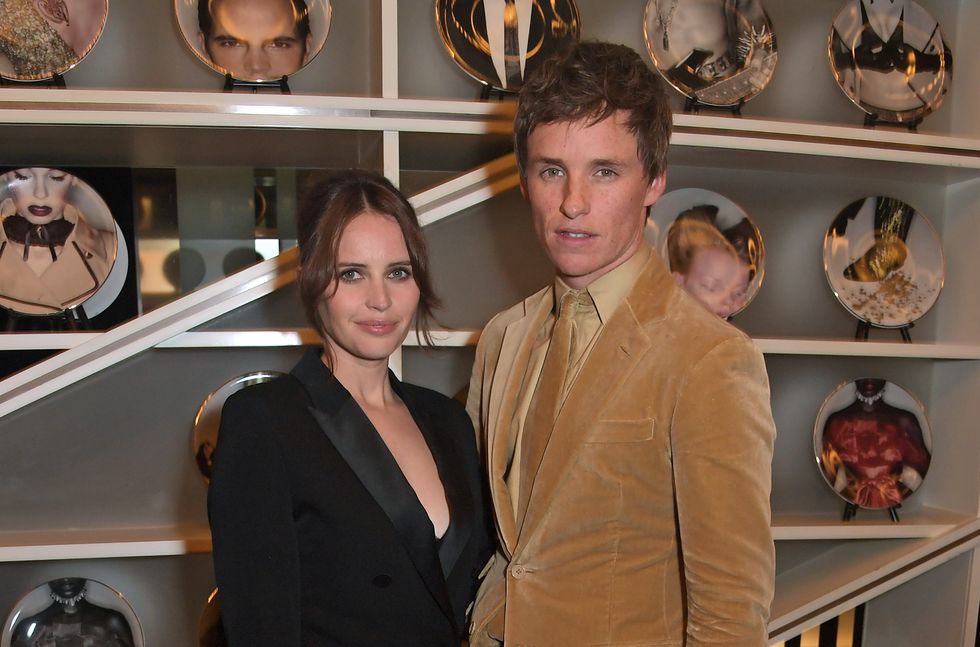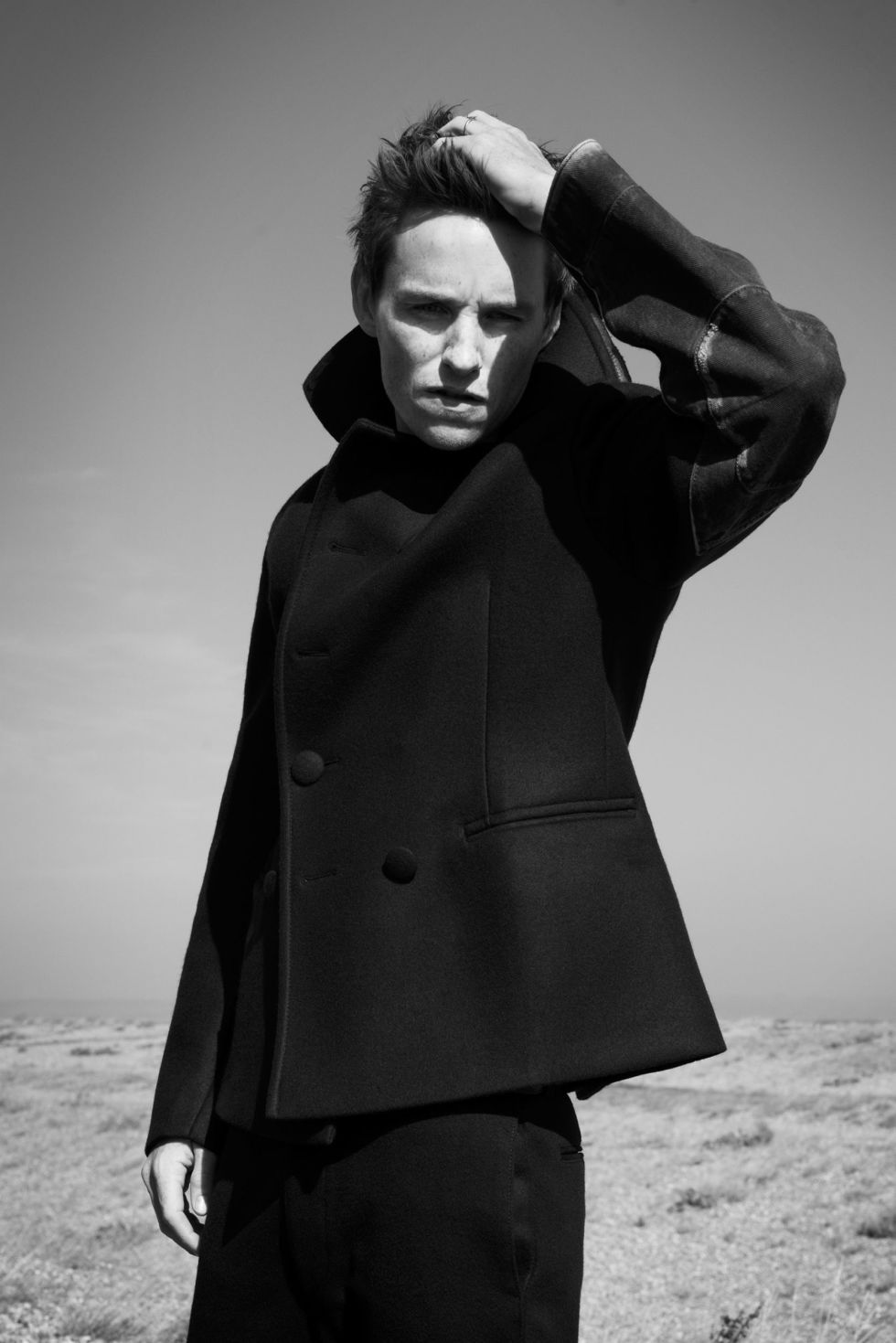Eddie Redmayne dashes over to the monitor, watching playback with his face inches from the screen. He shakes his head and mutters, eyes intent. “The thing is,” he says, staring at his miniature self, “for this to work it has to feel authentic.”
We’re on the set of The Aeronauts, an Amazon Originals film that’s loosely based on the book Falling Upwards, which chronicles a series of record-breaking air balloon flights, in 1862, by the two men who all-but invented modern meteorology. When The Aeronauts premiered at the Telluride Film Festival this autumn, it brought its stars, Redmayne and Felicity Jones, back together again for the first time since their pair-up in the Oscar-winning The Theory of Everything.
On the red carpet, the duo were all glamour. But in late summer 2018, while shooting the film's climactic scene, things are rather more brutal. Before each take, Redmayne and Jones – who play scientist James Glaisher and aeronaut Amelia Rennes – plunge their hands into a bucket of ice water. Then they set up for the next shot in their balloon basket, which is in a specially built blue-screen room chilled to just above freezing to simulate the numbing conditions at 37,000ft.
Later, on a break in her (mercifully warmer) trailer, Jones is animated and energetic, showing off her pull-ups on a bar that’s been set up for stretching and, well, pull-ups. “[This role is] really physical,” she said, “that's why I wanted to do it. [Amelia] is completely in her body; she’s rough and tumble, kind of a tomboy. She’s an adventurer and a pioneer.”
Jones' role in The Aeronauts has attracted attention for more than just her performance. When the director, Tom Harper, began working on the script with screenwriter Jack Thorne (Peaky Blinders, Wild Rose), they discovered a problem. The two people in the original balloon were men of a similar age, class and race. “It didn’t necessarily give the best opportunities for conflict and for character relationship,” says Harper, who directed some of the first season of Peaky Blinders, as the BBC miniseries War & Peace and Wild Rose.
There was a minor character from the book, 19th century balloonist Sophie Blanchard, who Harper was taken with. “I thought it would be nice to base a character on one of the female aeronauts, of which there are a few, and this one in particular was quite extraordinary,” he says. “If we only accurately told stories about the past, they would only contain white men. It’s not like I started out saying, ‘Oh, I need to change this from a man to a woman in order to address the imbalance.’ It was a natural storytelling decision – an opportunity for the characters. We quite clearly don’t suggest that this is real. There are some things based on fiction, some based on fantasy and the best stories are the combination of the two.”
Esquire caught up with Redmayne last September to discover what it was like working with Jones again, their process, her prowess, and his experience of flying in hot air balloons.
Whose idea was the bucket full of ice water?
That came after we started doing these scenes. We’d done all the makeup and the room was cold, but you get used to the cold quite quickly. And because it’s summer outside, it doesn’t quite embed in your body. Tom had this idea to push it to another level. And it does. I started to look at how cold works in the body, figuring out between where the bit where it hurts and the bit where you can’t actually physically move anything. It’s been this weird thing of investigating how far you can push your extremities to make it feel and look real whilst still getting them to do what they’ve got to be able to do – like how many blisters on your hands can you have without going too far, because otherwise it looks like you wouldn’t be able to hold instruments and ropes. It’s been a bit of a balancing act.
You’re no stranger to physically challenging yourself in a role. Is that what drew you to this character?
Interestingly, while both James and Amelia go through their own extremes in the story, it’s Felicity’s character this time who goes through the more physical extremes. The appeal for me to do this film was that it was unlike anything I’d read. It was this mixture of two people in a basket – which I found intriguing in itself – but it was about wonder and about looking upwards. So much of our world now is about looking down, down into things and into screens and scrutiny. The idea of the unexplored I found really moving.
What was it like working with Felicity Jones again?
When I was sent the script, I was told that they’d gone out to Felicity for it, so that’s how I read it, with her in mind. It was so different to anything I’d seen her in so far. It had gone so well for us last time, but there was that mixed feeling of wondering whether it will a second time. But I just adore her as a person, and she challenges me as an actor. And both of us knew that those were the stakes. So, actually we’ve gotten to do something completely different and push each other in different directions. There is something about working with someone whose process you admire and gels with your own. We rehearsed this film longer than any film I’ve rehearsed, in fact.
That’s almost hard to believe, considering you played Stephen Hawking.
We had two or three months of Felicity and I and Tom in a basket they built for us on a small stage. Quite often when you’re filming, you see the set for the first time the day that you walk onto it. The delicacy of this film is in the detail. It was before my wife was pregnant, and Felicity was about to get married, and that’s when we rehearsed for a couple of months. Felicity then got married, and Luke, my son was born. So, we took some time off having already rehearsed it. Then when we came back, it was there in our guts, but also quite new – because we’d rehearsed for quite a long time, but then there was the freshness of coming back to something with a renewed spirit.
Had you been in a hot air balloon before filming this movie?
No. Have you been in one?
No. I don't think most people have.
No, I don’t think they have. Well I found it kind of riveting. Though, it really was Felicity that did most of the work. She and Tom went to Germany and worked with gas balloons and hot air balloons, and she learned to pilot there in a gas balloon. And then the three of us went up in a hot air balloon here before we went up in our balloon that was built for the film. We played through some of the scenes and it was invaluable, that feeling when you’re that high up, how it affected everything. As far as the stunts were concerned, I mean, in those scenes, I’m just in a basket. Felicity was the one that had to climb up to the top. Her bravery was kind of astounding. Like, she is incredibly robust and I’m a bit pathetic.
Oh, surely not.
It’s actually true, I keep getting the salt bags in my face, they keep scratching me during our scene, and I asked Felicity, ‘Doesn't that hurt?’ and she says, ‘No, it gives a really good effect.’ She’s like, ‘Just run with it,’ and I’m like, ‘Ow!’ Physically, what she has to do in the film is much more extreme than anything I have to do. But it’s been such a wonderful thing to work with her again. I’ve never really gotten to repeat a dance partner again, who you trust, who you can challenge. It’s very inspirational.
Do you mean dance partner metaphorically?
[Laughs] Yes, sorry.
Because you have that line about dancing badly.
Oh, yes! There is a dance scene. Glaisher is a really shoddy dancer, so that actually took weeks of preparation. Even though he’s meant to be a shoddy dancer, Tom had to tell me a lot that I’m meant to be a bad dancer. But, I mean, there’s bad dancing and then there’s scene-ruining dancing.
The Aeronauts is in UK cinemas now.
















